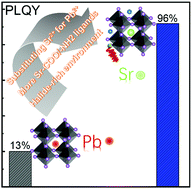Efficient blue CsPb(Br–Cl)3 nanoparticles enabled by strontium halide and amine halide synergetic optimization†
Abstract
Blue emitting CsPb(Br–Cl)3 perovskite nanoparticles (NPs) play an important role in optoelectronic applications. However, the synthesis of stable blue perovskite NPs with excellent photoluminescence quantum yield (PLQY) is still challenging. Here, a new strategy of conveniently using strontium halides and amine halides for simultaneous doping and surface passivation of CsPb(Br–Cl)3 perovskite NPs is proposed. Through experimental studies and calculations, it is found that divalent Sr2+ cations can partly replace the B-site Pb2+ ions in the lattice structure of perovskite NPs and cause a slight lattice contraction, not only passivating the defects but also providing chances for bluer NPs. As a result, the deep-blue CsPb(Br–Cl)3 perovskite NPs with PL emission centered at 455 nm and a high PLQY of 96% were obtained. In addition, a white light-emitting device (WLED) with the NPs as an emissive layer exhibited a maximum power efficiency of 76 lm W−1 with Commission International de L’Eclairage (CIE) coordinates of (0.33, 0.34). These findings provide fundamental insights into the excited state dynamics of colloidal cesium lead halide (CsPbX3) perovskite NPs that can be used as components of LEDs for practical applications.



 Please wait while we load your content...
Please wait while we load your content...